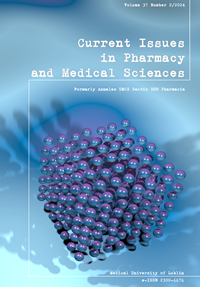Knowledge of the sign prohibiting alcohol consumption during pregnancy among medical students in Poland – a survey study
DOI:
https://doi.org/10.2478/cipms-2024-0015Keywords:
alcohol, pregnancy, health promotion, fetus, pictograms, health-promoting behaviorsAbstract
Signs, including pictograms, present in public space are intended to enforce a specific behavior. Due to their simplicity and unambiguity of the message, they can be an effective tool of public healthcare. The aim of this study was to assess the knowledge referred to the meaning of the sign prohibiting alcohol consumption during pregnancy among first-year medical students who do not have vast knowledge at present level in this field. The study was conducted among academic youth in Poland, and assumed a 5% risk of error, hence, for p <0.05 the differences were considered statistically significant. Out of the total number, there were 1,123 questionnaire forms correctly completed and these were further selected for the final analysis, which comprised of 751 by women and 372 by men. Among the respondents, over 92% properly recognized the sign warning against the use of alcohol during pregnancy. Moreover, more than 45% declared previous contact with this sign and above 53% claimed that they already had knowledge of the sing’s meaning. The graphic form of the sign allows for its correct interpretation, thus products which may become harmful especially to pregnant women and fetus can be clearly and legibly marked.
References
1. Hetea A, Cosconel C, Stanescu AAM, Simionescu AA. Alcohol and psychoactive drugs in pregnancy.Maedica(Bucur). 2019;14(4):397-401.
2. Popova S, Lange S, Probst C, Gmel G, Rehm J. Estimation of national, regional, and global prevalence of alcohol use during pregnancy and fetal alcohol syndrome: a systematic review and meta‐analysis.Lancet Glob Health. 2017;5:e290-9.
3. World Health Organization.Global status report on alcohol and health, 2018. Geneva: World Health Organization; 2018.
4. Bearak J, Popinchalk A, Alkema L, Sedgh G. Global, regional, and subregional trends in unintended pregnancy and its outcomes from 1990 to 2014: estimates from a Bayesian hierarchical model. Lancet Glob Health. 2018;6:e380-9.
5. Popova S, Dozet D, Akhand Laboni S, Brower K, Temple V. Why do women consume alcohol during pregnancy or while breastfeeding?Drug Alcohol Rev. 2022;41(4):759-77.
6. Greenmyer JR, Klug MG, Kambeitz C, Popova S, Burd L. A multicountry updated assessment of the economic impact of fetal alcohol spectrum disorder: costs for children and adults.J Addict Med. 2018;12:466-73.
7. Dathe K, Schaefer C. The use of medication in pregnancy.Dtsch Arztebl Int. 2019;116(46):783-90.
8. Towarek J.Znajomość systemów informujących o zagrożeniu toksycznością substancji wśród młodzieży(niepublikowana praca doktorska). Lublin: Uniwersytet Medyczny w Lublinie; 2018.
9. Marcotrigiano V, Lanzilotti C, Rondinone D, De Giglio O, Caggiano G, et al. Food labelling: Regulations and Public Health implications.Ann Ig. 2018;30(3):220-8.
10. Pettigrew S, Jongenelis M, Chikritzhs T, Slevin T, Pratt IS, et al. Developing cancer warning statements for alcoholic beverages.BMC Public Health. 2014;14:786.
11. Heenan M, Shanthosh J, Cullerton K, Jan S. Influencing and implementing mandatory alcohol pregnancy warning labels in Australia and New Zealand.Health Promot Int.2023;38(3):1-10.
12. Wogalter MS, Conzola VC, Smith-Jackson T. Research based guidelines for warning design and evaluation.Appl Ergon.2002;33:219-30.
13. Leoniak K.Rola uzasadnienia i sankcji w perswazyjności znaków zakazu i nakazu. Warszawa: Szkoła Wyższa Psychologii Społecznej; 2012.
14. Dimova ED, Mitchell D. Rapid literature review on the impact of health messaging and product information on alcohol labelling.Drugs Educ Prev Policy.2022;29:1-13.
15. Dumas A, Toutain S, Hill C, Simmat-Durand L. Warning about drinking during pregnancy: lessons from the French experience.Reprod Health.2018;15(1):20.
16. Millot A, Serra M, Gallopel-Morvan K. How the alcohol industry fought against pregnancy warning labels in France. A press coverage analysis spanning 20 years.Front Public Health.2022;10:933164.
17. O’Brien P. Warning labels about alcohol consumption and pregnancy: moving from industry self-regulation to law.J Law Med.2019;27:259-73.
18. England LJ, Benett C, Denny CH, et al. Alcohol use and co‐use of other substances among pregnant females aged 12‐44 years – United States, 2015‐2018.Morb Mortal Wkly Rep.2020;69:1009-14.
19. Popova S, Dozet D, O’Hanlon G, Temple V, Rehm J. Maternal alcohol use, adverse neonatal outcomes and pregnancy complications in British Columbia, Canada: a population‐based study.BMC Pregnancy Childbirth.2021;21:74.
20. Stanesby O, Cook M, Callinan S.Examining trends in alcohol consumption during pregnancy in Australia, 2001 to 2016. Canberra: Foundation for Alcohol Research and Education; 2018.
21. Lyall V, Wolfson L, Reid N, Poole N, Moritz KM, Egert S, et al. “The problem is that we hear a bit of everything…”: A qualitative systematic review of factors associated with alcohol use, reduction, and abstinence in pregnancy.Int J Environ Res Public Health.2021;18(7):3445.
Downloads
Published
Issue
Section
License
Copyright (c) 2024 Authors

This work is licensed under a Creative Commons Attribution-NonCommercial-NoDerivatives 3.0 Unported License.


